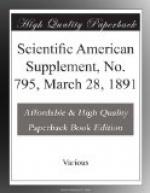By Prof. VIVIAN B. LEWES.
V.
Having now brought before you the various methods by which ordinary coal gas can be enriched, so as to give an increased luminosity to the flame, I wish now to discuss the methods by which the gas can be burnt, in order to yield the greatest amount of light, and also the compounds which are produced during combustion.
In the first lecture, while discussing the theory of luminous flames, I pointed out that, in an atmospheric burner, it was not the oxygen of the air introduced combining with and burning up the hydrocarbons, and so preventing the separation of incandescent carbon, which gave the non-luminous flame, but the diluting action of the nitrogen, which acted by increasing the temperature at which the hydrocarbons are broken up, and carbon liberated, a fact which was proved by observation that heating the mixture of gas and air again restored the luminosity of the flame. This experiment clearly shows that temperature is a most important factor in the illuminating value of a flame, and this is still further shown by a study of the action of the diluents present in coal gas, the non-combustible ones being far more deleterious than the combustible, as they not only dilute, but withdraw heat.
Anything which will increase the temperature of the flame will also increase the illuminating power, provided, of course, that the increase in temperature is not obtained at the expense of the too rapid combustion of the hydrocarbons.
As has been shown in the experiments relating to the action of diluents on flame, already quoted, oxygen, when added to coal gas, increases its illuminating value to a marked and increasing degree, until a certain percentage has been added, after which the illuminating power is rapidly decreased, until the point is reached when the mixture becomes explosive. This is due to the fact that the added oxygen increases the temperature of the flame by doing the work of the air, but without the cooling and diluting action of the nitrogen; when, however, a certain proportion is added, it begins to burn up the heavy hydrocarbons, and although the temperature goes on increasing, the light-giving power is rapidly diminished by the diminution of the amount of free carbon in the flame.
It has been proposed to carburet and enrich poor coal gas by admixture with it of an oxy-oil gas made under Tatham’s patents, in which crude oils are cracked at a comparatively low temperature, and are there mixed with from 12 to 24 per cent. of oxygen gas. Oil gas made at low temperatures, per se, is of little use as an illuminant, as it burns with a smoky flame, and does not travel well, but when mixed with a certain amount of oxygen, it gives a very brilliant white light, and no smoke, while as far as experiments have at present gone, its traveling powers are much improved.




